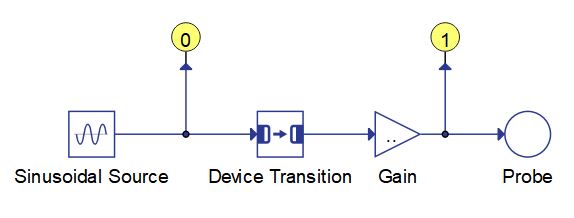Device Transition
Description of the Device Transition component in Schematic Editor.

Note: In TyphoonSim, every part of the model
is executed on single PC, thus Device Transition will basically behave like Rate
Transition component.
The Device Transition component manages data transfer between
components that operate on different HIL devices in a multi device setup. Input and output
execution rates may differ.
- Maximum vector width is 16.
- Maximum number of devices transition components from device A to device B depends on a chosen device type.
In order for two Signal Processing circuits that run on different devices to exchange data, they should be connected using the Device Transition component as illustrated in Figure 2.

Device Transition component can introduce a delay of one execution rate.
Ports
- in
- Input signal coming from the source device.
- Supported types: uint, int and real.
- Vector support: yes.
- Input signal coming from the source device.
- out
- The output signal present on the destination device, with the same value as the
input signal. The execution rate of the signal is defined using the Execution
rate property.
- Supported types: uint, int, and real.
- The output type is inherited from the input signal.
- Vector support: yes.
- The vector length is inherited from the input signal.
- Supported types: uint, int, and real.
- The output signal present on the destination device, with the same value as the
input signal. The execution rate of the signal is defined using the Execution
rate property.
Properties
- Initial value
- Specifies the initial value of the output signal at the beginning of the simulation.
- Execution rate
- Type in the desired signal processing execution rate. This value must be compatible with other signal processing components of the same circuit: the value must be a multiple of the fastest execution rate in the circuit. There can be up to four different execution rates. To specify the execution rate, you can use either decimal (e.g. 0.001) or exponential values (e.g. 1e-3) in seconds. Alternatively, you can type in ‘inherit’ in which case the component will be assigned execution rate based on the execution rate of the components it is receiving input from.